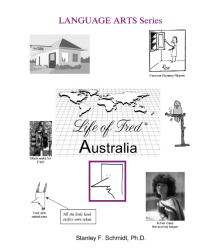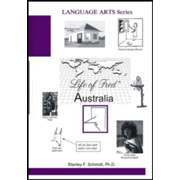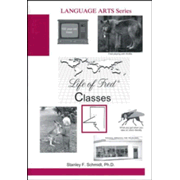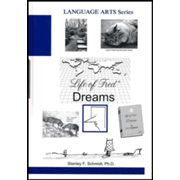The Life of Fred Language Arts Series might transform the way older students view grammar just as the Life of Fred Math Series has upended all of the normal expectations about the nature of math courses. This series is intended for high school students, but I think younger students will also want to read the books.
Author Dr. Stanley Schmidt teaches grammar but not in an organized fashion and not in isolation. Five-year-old Fred Gauss, the main character in all Life of Fred books, is a precocious instructor of mathematics at KITTENS University. In the language series there is an underlying story thread. Fred responds to an advertisement from the Board of Missions asking for volunteers and ends up taking off for Australia without clarifying the work he will be expected to do. Within the context of that story line, Dr. Schmidt teaches points of grammar along with discursions into math, geography, science, and other topics. The humorous events resulting from Fred’s adventures as well as Dr. Schmidt’s unique style of presentation make these books fun to read, even for adults. Chapters are each about four pages length, and each one concludes with a “Your Turn to Play” exercise just as in the math books. Exercises are brief and answers are on the following page. In the language series, students need to write out their own answers before checking them—oral responses will not suffice since exercises often deal with homonyms, punctuation, formation of plurals and other skills that involve the ability to correctly spell and write. However, these exercises are very minimal compared to most grammar workbooks.
Books look much like the Life of Fred Math books. Printed in black-and-white, they include lots of amateurish illustrations—drawings, clip art, and photos. Dr. Schmidt makes the point from time to time that he's terrible at art. Yet the art adds significantly to the humorous nature of the books.
There are four books in this series: Australia, Begin Teaching, Classes, and Dreams. Notice that rather than grade level designations, books are titled with words that indicate a progression by the alphabetical order of their titles. The progression has to do with the story line as much or more than with the language arts instruction. Dr. Schmidt does not try to cover everything, since I’m sure he assumes that students have had at least some prior instruction. For example, he spends minimal time defining and giving examples of the parts of speech, instead dedicating more time to challenging aspects of using those parts of speech. Similarly, he spends more time on trickier aspects of punctuation than on the basics.
All students should start with Australia or else they won’t understand the story. While the series is intended for high school students, I would read this book with students as young as fourth or fifth grade, although I would not expect them to master all of the content.
Australia teaches topics such as punctuation (including punctuating quotations), eight ways to make plurals, homonyms, heteronyms, some capitalization rules, subjunctive mood, and hyperbole. It also throws in diverse topics such as the disputed definitions of islands and continents, parallel lines, magnetic pole reversals, the reversal of seasons in the Northern and Southern hemispheres, and the explorations of Daniel Boone.
Begin Teaching covers topics such as subject/verb agreement, verb conjugations (for all 12 tenses—although the six perfect tenses get only brief mention), more ways to create plurals, the meter of poems, the schwa, the semi-colon, appositive phrases, comma splices, and irregular and regular verbs. Along the way, we also learn about subjects such as kangaroos, the metric system, the theme of Moby Dick, the origin of computers, and the definition of existentialism. I would save this book for students at least sixth grade level and above, although younger children will still love the story of Fred.
The third book, Classes, seems more focused on grammar as it teaches about seven parts of speech, the use of italics, transitive and intransitive verbs, infinitives, auxiliary verbs, rules for adding suffixes, cases of nouns, mood, antecedents of pronouns, hyphens, en dashes, and em dashes. While some junior high students might be ready for this book, I would generally recommend it as well as Dreams for high school level.
Among the grammar topics taught in Dreams are complex sentences, clauses, coordinating and subordinating conjunctions, correlative conjunctions, conjunctive adverbs, parentheses, brackets, braces, and slashes. This book devotes a bit more attention to the writing process as Dr. Schmidt teaches about active and passive voice, parallel structure, outlining, the structure of an essay, metaphors, synecdoches, metonymies, logic, and plagiarism.
Summary
The Life of Fred Language Arts Series has the same advantages and disadvantages as does the math series. The books are fun to read, but the subject matter covered doesn’t always fit into a logical sequence. Some subject matter seems appropriate for at least high school level while other lessons address material generally taught at younger grade levels. However, more attention is given to more challenging and problematic aspects of grammar while less is devoted to topics students are likely to have mastered. Dr. Schmidt does a great job of presenting the rules as well as the reality—for example, he presents the seven rules regarding doubling consonants when adding suffixes, but he says, “Please do not read this if you want to stay sane” (p.83).
I suspect that most high school students will have had their fill of grammar by the time they hit high school, yet they still need to fine-tune or brush up their grammar skills. Life of Fred Language Arts should be perfect for that purpose.














